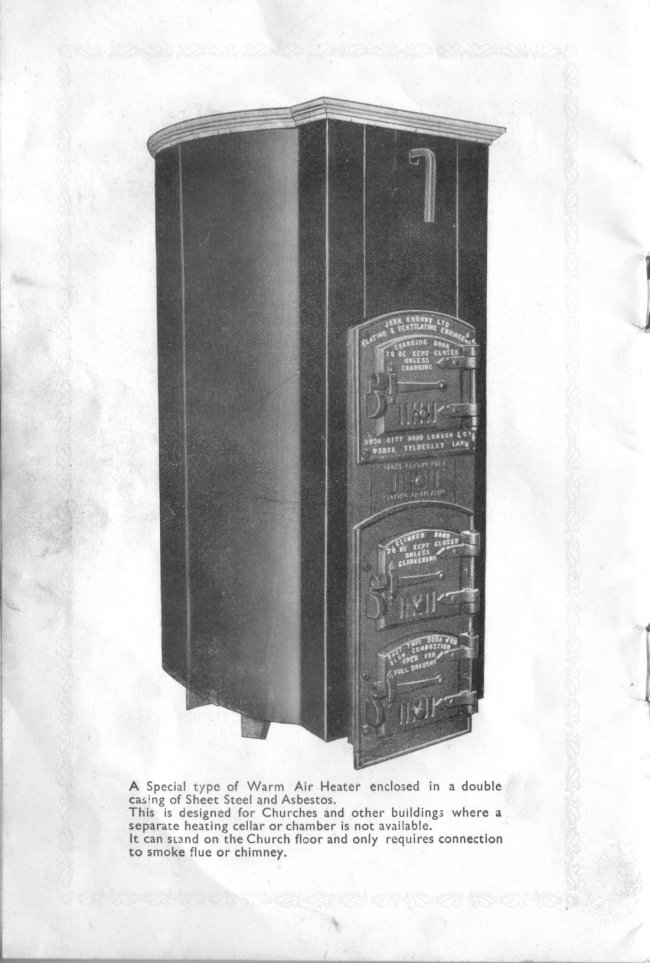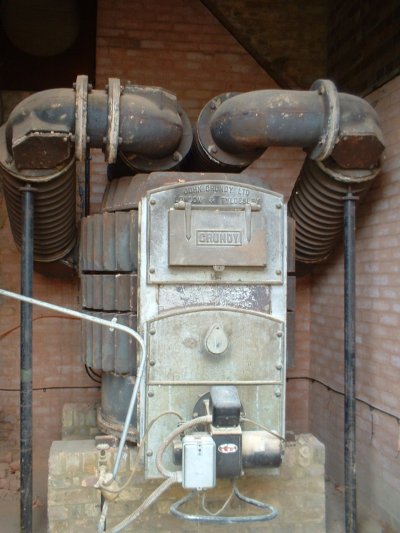
A short and varied history
about
John Grundy
(first President of the IHVE 1898)
- the family tree
- the firm John Grundy Ltd
- the Patents
- the Grundy warm air stove
- the equipment they manufactured
- two examples of stoves in churches
- firms advertisements and testimonials
- the internal re-bricking of a stove's combustion
chamber
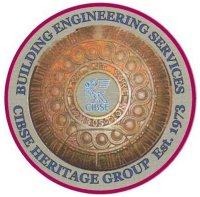
Researched, prepared and
written by F J Ferris for the
Heritage Group of the CIBSE
February 2005
with acknowledgements to,
Edward L Jones of Tyldesley, Manchester
Gordon Fishwick of Bolton, Manchester
Nigel Crisp of Hadleigh, Suffolk
Mike Penny of Cockfosters London
Mike Haddon, Wigan Heritage Service,
Wigan Leisure & Culture Trust
British Library Patents Section
for their assistance and information.
| The following website
article about John Grundy is an ongoing Heritage Group
project. More webpages will be added as further
information is discovered. |
|
INTRODUCTION
John
Grundy (senior & junior) were another two of
the engineering pioneers who shaped the Heating
& Ventilating industry, whose inventions
during the latter half of the Victorian period led
to dramatic improvements in the comfort levels of
the congregations attending church services. The
warm air stove apparatus they patented was
installed in numerous ecclesiastical buildings
throughout Britain. Many of these stoves are still
in use today, a tribute to their engineering
design and craftsmanship. When the Institution of
Heating & Ventilating engineers was
incorporated in 1897 John Grundy jnr was elected
to become its first President for 1898. The
Heritage Group considered it a fitting tribute to
prepare this article and record their
achievements. |
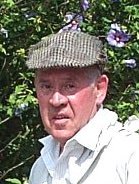 |
A special thank you is given to Gordon Fishwick of Bolton Lancashire who as an ex-employee of John Grundy Ltd has been able to provide the Heritage Group with many facts, memories, drawings and photographs about the firm. All this relevant information would otherwise have remained unknown as the majority of the firms documents and drawings were removed and destroyed when the firm closed. |
| John Grundy & Family |

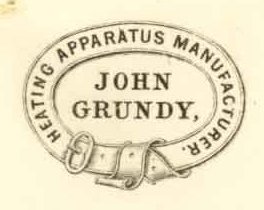
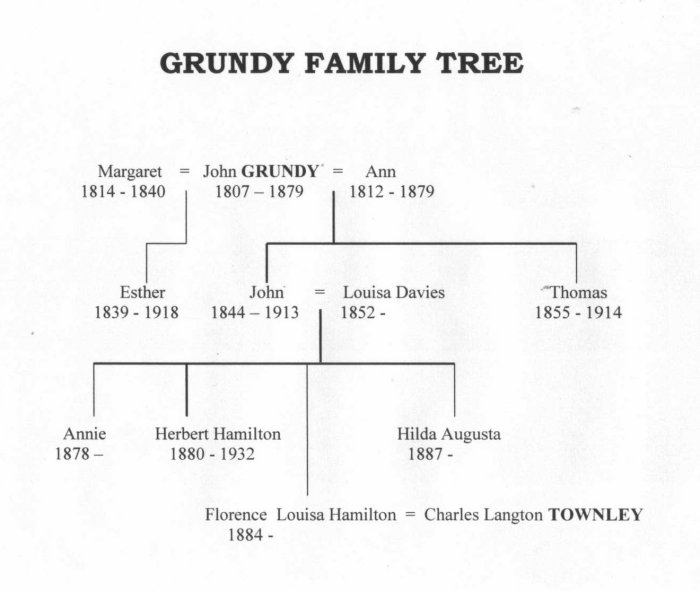
|
John Grundy (1807
- 1879) was a Grocer and Flour Dealer
who lived in Elliott Street, Tyldesley, near
Manchester. He
attended the congregation of Top Chapel where he was a
Churchwarden and was mos
 t concerned at the
discomfort he felt t concerned at the
discomfort he felt 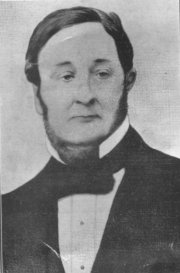 during
the winter, in both the Shop and Chapel. So he set
about resolving the problem and overcome this
discomfort, and after some time came up with an idea.
He asked permission to carry out an experiment in
heating the Chapel by using the schoolroom conveniently-sited
below the Chapel. He erected a
central heating apparatus by using a stove, flues,
chimney and ventilators and succeeded in warming the
Chapel. during
the winter, in both the Shop and Chapel. So he set
about resolving the problem and overcome this
discomfort, and after some time came up with an idea.
He asked permission to carry out an experiment in
heating the Chapel by using the schoolroom conveniently-sited
below the Chapel. He erected a
central heating apparatus by using a stove, flues,
chimney and ventilators and succeeded in warming the
Chapel. To
manufacture and market the central heating apparatus
the company John Grundy Ltd was established in 1857
with an address in Lower Elliott Street Tyldesley. To
secure the success of the heating apparatus he
applied for and was granted Patent, BP 2949 in 1864.
He continued to improve upon the heating apparatus,
increasing its efficiency and effectiveness, and
additional Patents were taken out in later years.
John
Grundy died in Tyldesley on 20th March 1879 his second
wife Ann having died 2 months previously in
January. A monument dedicated
to John Grundy and members of his family is sited
at the entrance to Top Chapel in the graveyard with an
inscription noting his achievement for inventing
a method of heating for the Chapel.
|
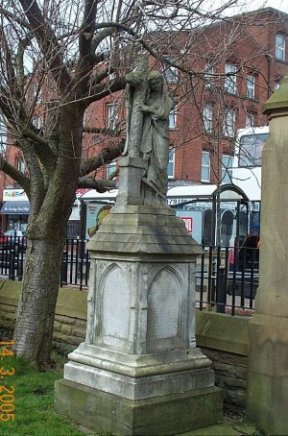 |
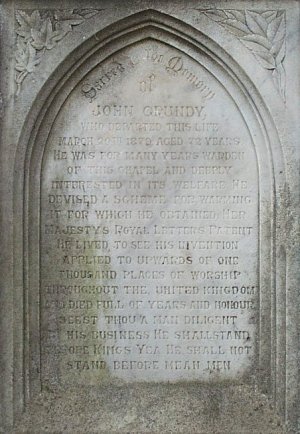 |
|
John
Grundy
(1844 - 1913)
was the first son born to John and Ann
Grundy.
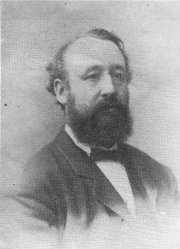 By the age of 17 in 1861 he had joined
his parents in their shop, also working as a
Grocer. However even with the establishment of
the heating firm both John snr and John jnr continued
to keep their old occupations, as the census of 1871
still lists both of them as flour dealers. By the age of 17 in 1861 he had joined
his parents in their shop, also working as a
Grocer. However even with the establishment of
the heating firm both John snr and John jnr continued
to keep their old occupations, as the census of 1871
still lists both of them as flour dealers.
By
the 1870's the firm had become a successful business
which was changing the fortunes for him and his
family. It is possible that John jnr decided the
future direction and expansion for the firm should be
concentrated in London. He
married a Welsh girl Mary
Davies from Brynmawr Breconshire in 1878. The
census of 1881 shows that he has moved south with his
family to a larger residence in Hackney London where
their four children Annie, Herbert, Florence and Hilda
were born.
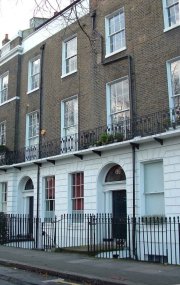 They
moved house again later in the 1880's into a more
fashionable area residing at 30 Duncan Terrace,
City Road, Islington London. This became his Head
Office from where he controlled and operated his
greatly expanded business. They
moved house again later in the 1880's into a more
fashionable area residing at 30 Duncan Terrace,
City Road, Islington London. This became his Head
Office from where he controlled and operated his
greatly expanded business. Now
calling himself a Heating and Ventilating Engineer,
the firm opened new show rooms and work rooms at
Torrens Street Islington, also
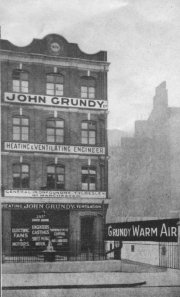 393a City Road London, and a
West End branch was opened at 57 Wigmore Street
Cavendish Square. 393a City Road London, and a
West End branch was opened at 57 Wigmore Street
Cavendish Square. The Grundy warm air stove heating apparatus proved a great success and was installed in several Cathedrals, and numerous Churches and Chapels throughout the country. To handle the increasing demand for this heating apparatus an iron foundry and works was built in Parr Street Tyldesley in 1886. The foundry gave the firm the ability to produce a greater range of heating equipment which now included such items as Ward Stoves, Fire-grates, cast iron pipes, fittings, radiators, ventilators and ranges.
Confirmation
that his business was now very successful is apparent by
the presentation of 27 Medals awarded to the firm at
various exhibitions and also the numerous testimonials
written to him by satisfied Clients and Customers after
the installation of his heating and ventilating
apparatus in their building/s. From the first stoves
erected in Churches, the type of buildings they now
heated had expanded substantially to include Public
Schools, Mansion Houses, Hospitals, Law Courts, Factories, Warehouses, Workhouses
and Institutions. He died at his
home Mountfield, Wood Lane, Highgate, London on 27th
April 1913. In his will he left the significant sum of
£23,739 to his three survivng children. |
| The
trade
names given to the firm's various heaters are either
taken from Greek mythology or star signs. Someone in the
firm was very knowledgeable and interested in the Greek
Classics. ref 1.- Hestia in Greek religion, is goddess of the hearth, daughter of Cronus and Rhea, and one of the 12 Olympian deities. In later philosophy Hestia became the hearth goddess of the universe. ref 2. - Helios is the young Greek god of the sun, and the son of Hyperion and Theia. By the Oceanid Perse, he became the father of Aeëtes, Circe, and Pasiphae. Helios was worshipped in various places of the Peloponnesos, but especially on Rhodes, where each year gymnastic games were held in his honour. |
| John Grundy jnr
from his humble start in life proved he was a person
with a vision. He saw the opportunity following the
invention of the warm air stove, to continue in
business in the Heating &
Ventilating industry,
and went on to create and Patent other inventions
providing a lifetime of achievements. His
business of manufacturing different items of heating
equipment proved very successful with hundreds of
his stoves being erected, one as far away as the
Falkland Islands, and the fact that some of his
stoves are today still heating their original
buildings is a tribute to his engineering design and
craftsmanship. He was a true Victorian entrepreneur,
and made an important contribution to the H&V
industry. When the Institution of Heating
Ventilating Engineers was incorporated in 1897 John
Grundy jnr was considered a worthy engineer and
candidate and was elected to become its first
president in 1898. |
THE LIST OF THEIR PATENTS
| Number
2949 25th November 1864
Apparatus for heating
rooms or buildings Number 5594 28th March 1884 Warm air fire grate Number 7141 29th April 1889 Improvements in Apparatus for Warming currents of Cold Air Number 8455 21st May 1889 Improvements in Underground Air Warming Apparatus Number 15210 25th September 1890 Improvements in Open Fire-grates |
PATENT No. 2949 dated 1864
|
A
stove having at the top part a pipe connected by
a flue to the chimney, and place the said stove
in a chamber surrounded by brickwork,
earthenware, or other suitable material, so as
to allow a space between the stove and wall of
the chamber. Near the bottom of the chamber
there are apertures in the walls for the
entrance of cold air to be heated by the stove
when the fuel is in a state of ignition,
the upper apertures at the top of the chamber
allow the egress of heated air, communicating
with other apartments or with the atmosphere to
take off the excess.
|
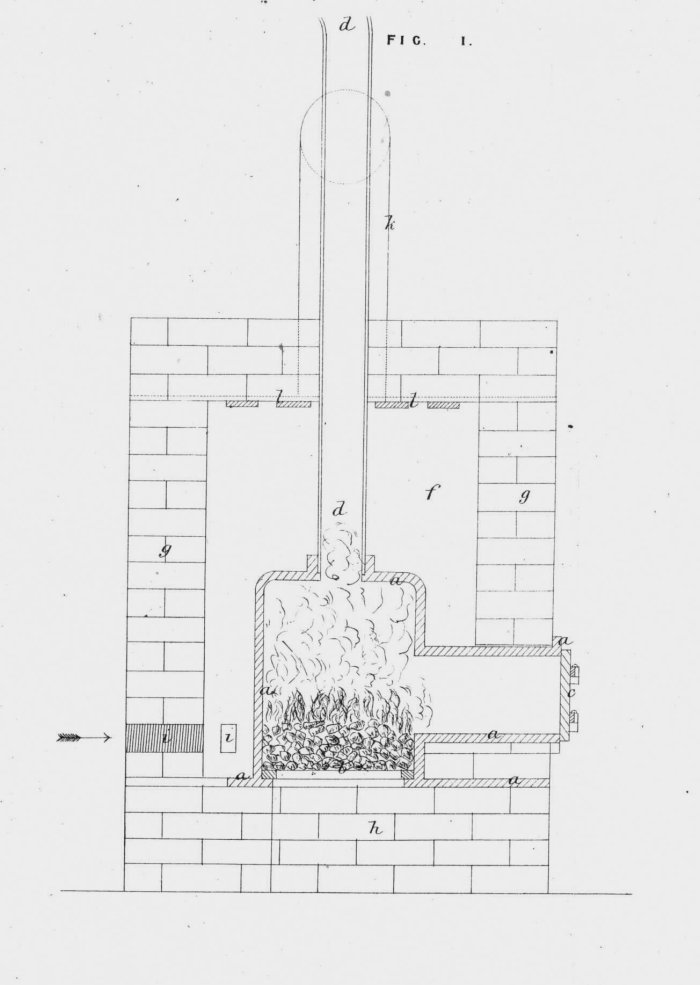
b - the grate or fire-bars
c - the fire door
d - the flue or pipe leading to the chimney
f - the chamber
g - the walls
h - the ash-pit
i - the apertures opening into the chamber for the admission of cold air
k - the pipes for the conveyance of the air heated by the heat of the stove
l - iron bars built into the brickwork to support the bottom of the pipes
| The invention
relates to improvements in fire grates. In
carrying it into effect, the back is made
preferably in one piece with its sides and
smoke-nozzle. The smoke flue is led up inside
the chimney for some distance, and for that
distance the chimney being cut off from the
flue proper, and being placed in communication
with the open air and the room to be warmed,
serves as a warming chamber. |
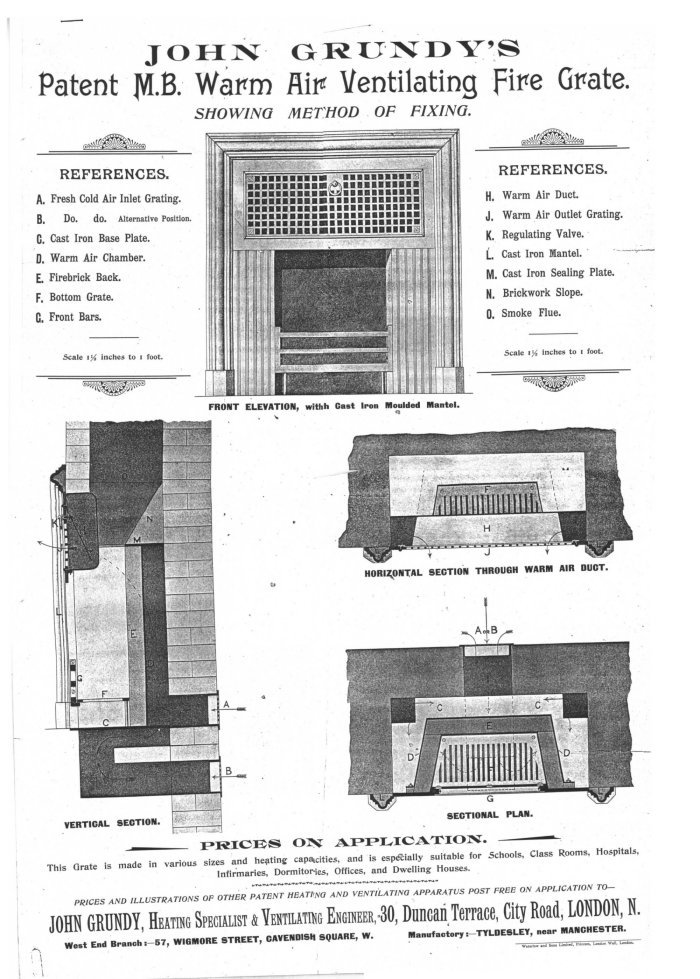 |
|
Herbert
Hamilton
Grundy (1880 - 1932)
the only son of John
& Louisa Grundy, was born
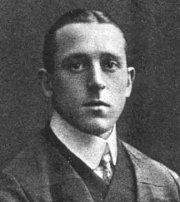 in Hackney
London in the autumn of 1880. He was
Educated
at
Islington High School, the Northampton
Institute and Northern Polytechnic. in Hackney
London in the autumn of 1880. He was
Educated
at
Islington High School, the Northampton
Institute and Northern Polytechnic.From 1896 -
1900 during his training he was
involved in erecting and supervising H&V work,
afterwards working at the Grundy Foundry in
Tyldesley near Manchester learning foundry work and
pattern making. Herbert
joined the IHVE in 1903 and presented a paper to
the Institution in 1904 titled "The
Warming of Public Buildings by the Warm Air
System considered from the Hygienic Point of
View". He became President
of the IHVE for 1915 / 1916, and gave as his
presidential address a paper titled "Short
review of past activities".
From 1910 -
1917 he worked on the design and manufacture of
equipment for a system of electrical heating using a
method of thermostatic control. During this period
he took out several Patents connected with his
work. He developed an electrical method of
thermostatic control for equipment such as electric
stoves, immersion heaters, and control valves for
steam, gas and hot water distribution systems.
Herbert patented a thermostatic apparatus for
controlling an electric motor driven fan which could
be used for heating industrial and educational
buildings. He also devised a type of remote reading
thermometer. Upon the
death of his father in 1913 he became Managing
Director of John Grundy Ltd. When the
Great War started in 1914 John Grundy Ltd was placed
under Government control and the firms production
was then concentrated upon the maufacture of
munitions for the war effort. He died at
the Great Northern Hospital Holloway, Middlesex on
the 13th May 1932 at the relatively young age
of 51. |
The List of His Patents
| Number 24162
31st October
1911
Hygrometer Number 5311 2nd March 1912 Thermostats Number 18017 3rd August 1912 Electric Heaters Number 15438 2nd November 1915 Measuring plasticity of rubber Number 110938 1917 Thermostats Number 158931 1921 Thermostats Number 205625 25th October 1923 Drying foundry moulds Number 210497 28th January 1924 Electric Heaters for use with fans |
| Most of Herbert Grundy's Patents relate to electrical appliances, the subject that occupied the majority of his inventive time. However one Patent he applied for departed greatly from all his other Patents and utilised the Grundy stove as a heater for drying cores and moulds in foundries, enamelled or Coated Articles and the like. |
PATENT No. 205,625 dated 1923
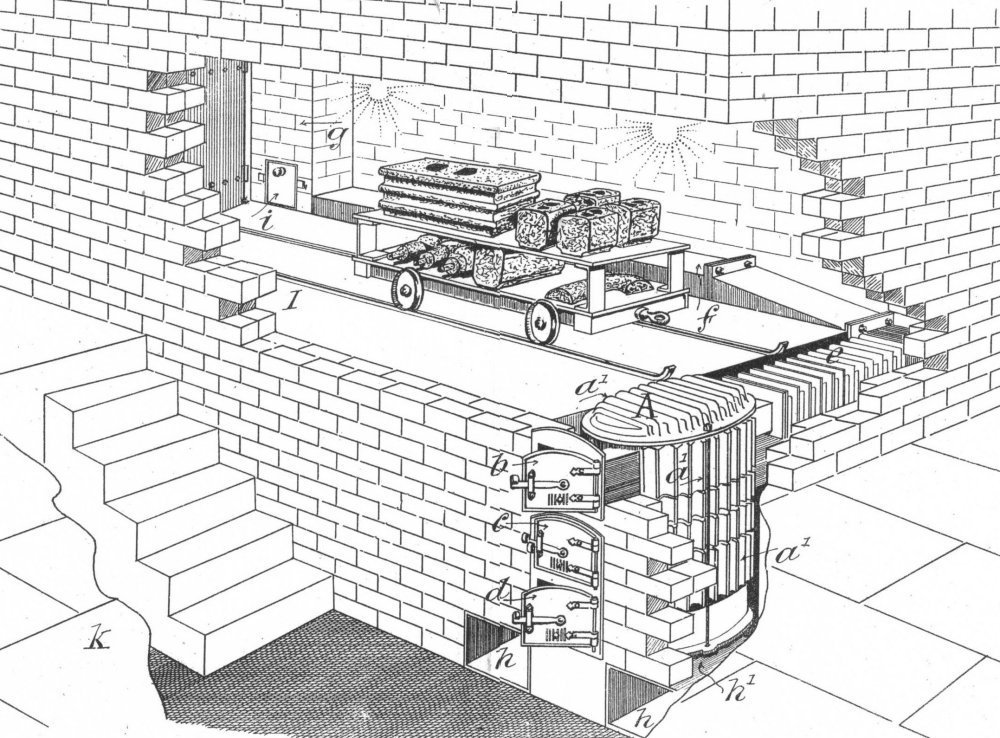
PATENT No. 18,017 dated 1912
|
This
invention relates to electric heaters and
particularly to heaters in which means are
provided for rendering the atmosphere humid when
the heater is in operation, the chief object being
to provide improved means for humidifying the
atmosphere and to enable the degree of evaporation
to be varied in accordance with requirements.
|
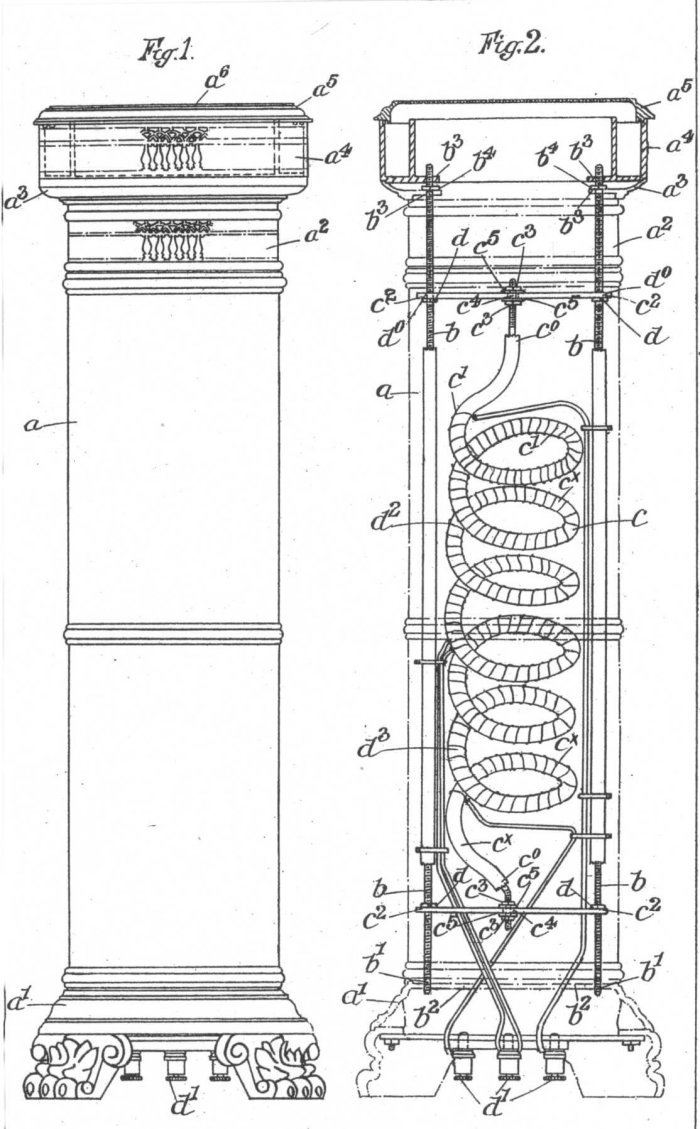
THE FOUNDRY
& IRONWORKS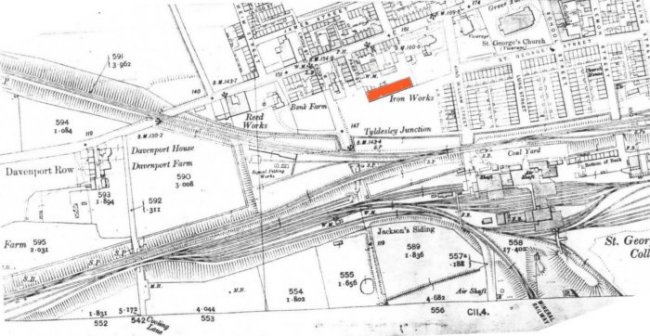 Part of Ordnance Survey Map of Tyldesley 1908 |
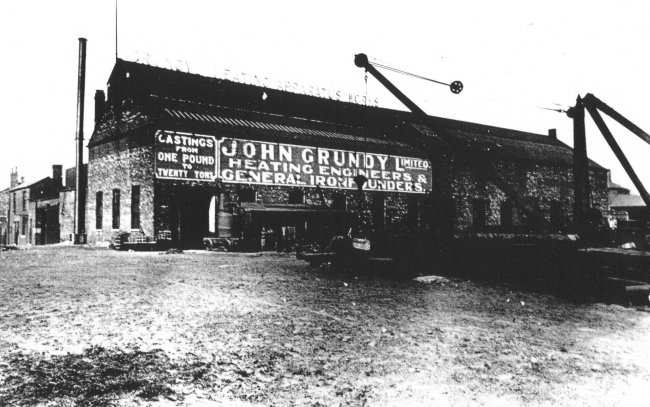 copyright of Wigan Heritage Service - Ref No. 367 / 16 |
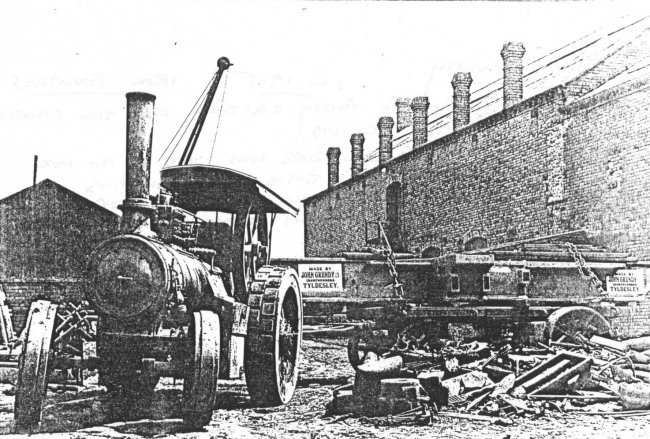 copyright
Wigan
Heritage Service Ref No. 367 / 10
Large grinder body casting for the for The Churchill Machine Co Ltd This grinder was said to be for finishing periscope tubes for submarines. The steam traction engine was used to haul it to its destination as there were no petrol wagons powerful enough to haul a 15 ton load at the time |
| John Grundy Ltd 1857 - 1974 (established 1857) |
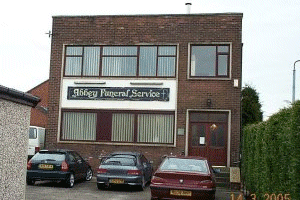 When the link between the Grundy family and
the firm ended in 1932 with the death of Herbert
Grundy, the firm continued with its 60 factory and 6
staff employees to advertise and manufacture the
successful range of heating apparatus which carried on
being installed in many more churches and other
buildings throughout Britain. One of the firms
marketting strategies was to post advertisement
literature to vicarages listed in Crockfords Clerical
Directory. This method must have proved successful as
it is estimated that in the 110 years of the firms
existence several thousand heaters were
installed. From the 1940's onwards in addition to the
heaters, the foundry also took on
jobbing work for the Iron Works making a large
selection of castings for items such as,
When the link between the Grundy family and
the firm ended in 1932 with the death of Herbert
Grundy, the firm continued with its 60 factory and 6
staff employees to advertise and manufacture the
successful range of heating apparatus which carried on
being installed in many more churches and other
buildings throughout Britain. One of the firms
marketting strategies was to post advertisement
literature to vicarages listed in Crockfords Clerical
Directory. This method must have proved successful as
it is estimated that in the 110 years of the firms
existence several thousand heaters were
installed. From the 1940's onwards in addition to the
heaters, the foundry also took on
jobbing work for the Iron Works making a large
selection of castings for items such as,Brick Making Plants for Sutcliffe & Speakman, Gear wheel blanks,
Gas street lamps and Fire surrounds.
During the 1939-1945 war, drainage gratings were made for the RAF which were used for the removal of rain water from airfield runways.
In the early 1950's 3 large Igranic heaters were exported to South Africa for a tobacco drying plant in Luchenza.
 During this time period
John Grundy Ltd had a reciprocal agreement with the
Blackburn firm Blakewater Foundry and they regularly
passed work to each other until the closure of
the Blakewater foundry. The inscription wording on
this access door at the United Reformed Church
Hadleigh installed in the 1950's confirms that the
Blackburn foundry was producing castings for John
Grundy Ltd
During this time period
John Grundy Ltd had a reciprocal agreement with the
Blackburn firm Blakewater Foundry and they regularly
passed work to each other until the closure of
the Blakewater foundry. The inscription wording on
this access door at the United Reformed Church
Hadleigh installed in the 1950's confirms that the
Blackburn foundry was producing castings for John
Grundy Ltd The unfortunate combination of poor management, unproductive workers and a lack of capital funding for future investment, aggravated by the recession in the early 1970's most likely brought about the demise and final closure of the firm. The closure of John Grundy Ltd in 1974 saw the iron foundry taken over for a short period by the Yorkshire firm Edgar Alan Ltd. Demolition of the foundry buildings in 1989 brought to an end over 100 years of iron making in Tyldesley.
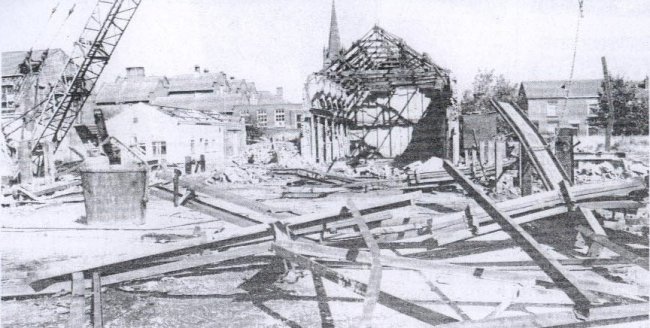
| THE GRUNDY WARM AIR STOVE |
| The Grundy warm air stove heating installation from the examples seen to date, was erected in a separate space or room that then acted as a plenum chamber for the warmed air. This warmed air was then routed away from the plenum chamber through ventilating ducts which supplied the other parts of the building, and introduced the air to the rooms and spaces through gratings or grilles fitted at floor level. Grundy warm air stoves were erected in many Cathedrals and Churches throughout the country and some of these stoves still exist today. Many of the Grundy stoves although originally designed to be solid fuel fired were readily converted to oil or gas firing during the 1900's. The main competitors of John Grundy Ltd for warm air stove installations in that Victorian time period were Haden and also the Gurney stove which by comparison was of the stand-alone type, installed within the space being heated. Whilst both the Haden and Gurney stoves ceased being installed from the early 1900's the Grundy stove was still being made and installed right up until the very early 1970's. |
The Grundy stove's catch phrase was their speciality
"PURE WARM AIR"
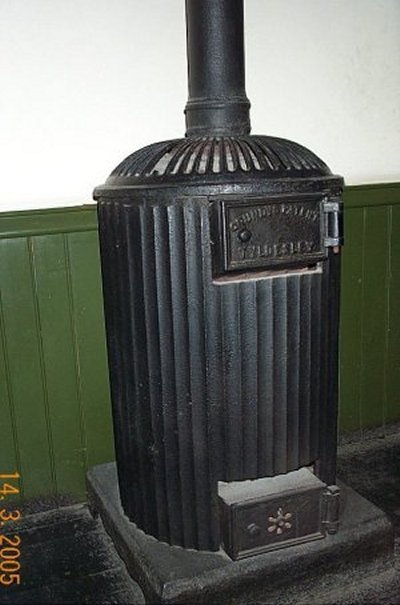 |
TYLDESLEY
CEMETERY CHAPEL This photo shows a very early pattern of a Grundy Warm Air stove which was removed from the Chapel and is now on display in "The Way We Were" exhibition at the Wigan Pier Heritage Centre Museum. 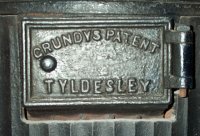 |
|
A technical description of the the Grundy warm air stove apparatus, its construction and operation is given in the book titled "Hood on Warming Buildings" by Frederick Dye (an IHVE member in the 1899 list of members) published in 1897. Relevant details of the apparatus extracted from the book are as follows. |
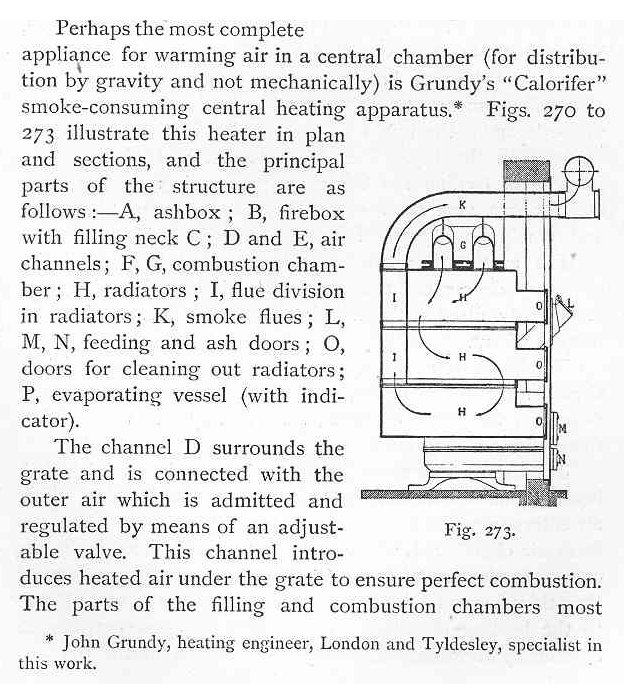
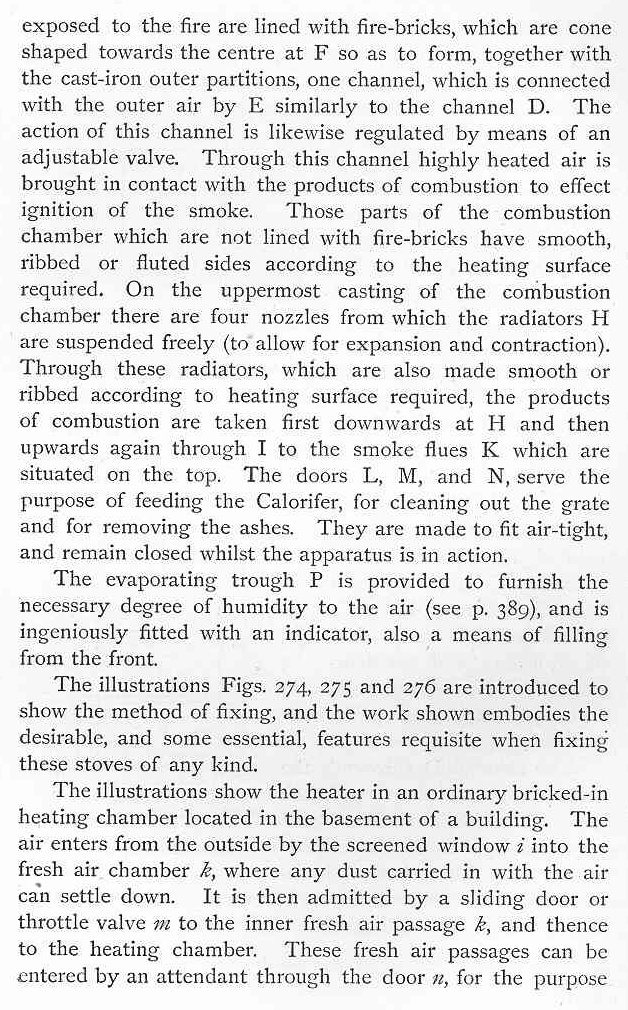
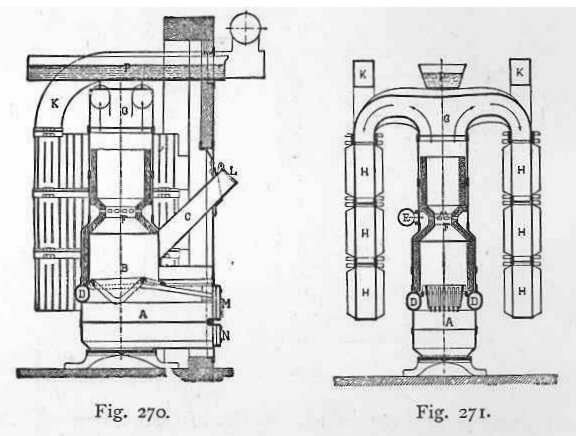
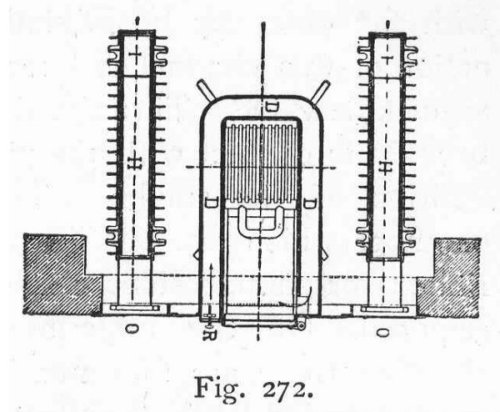
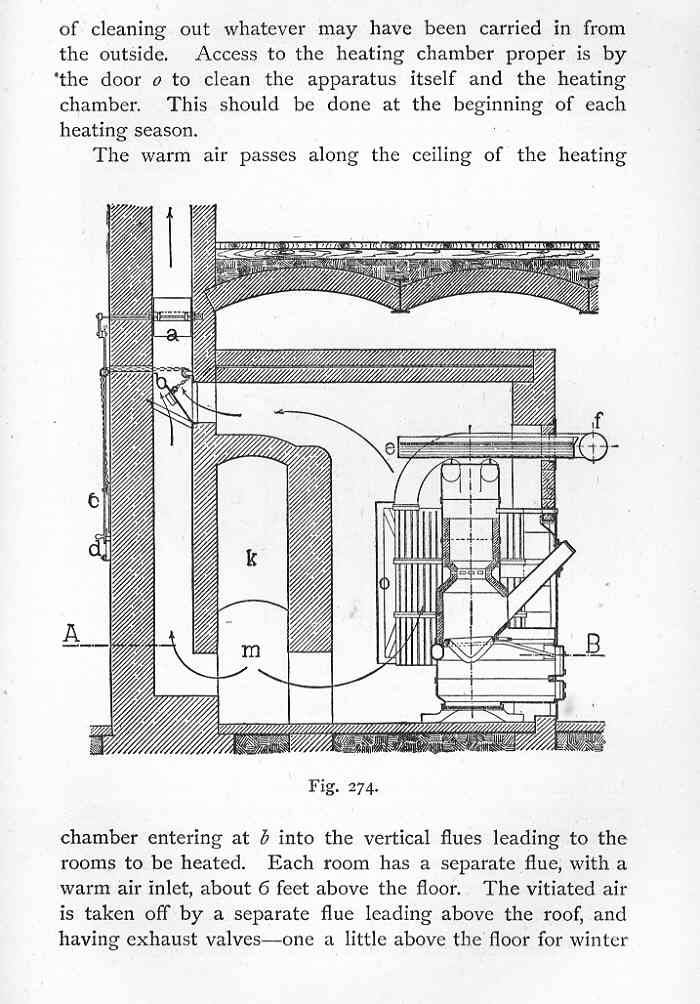
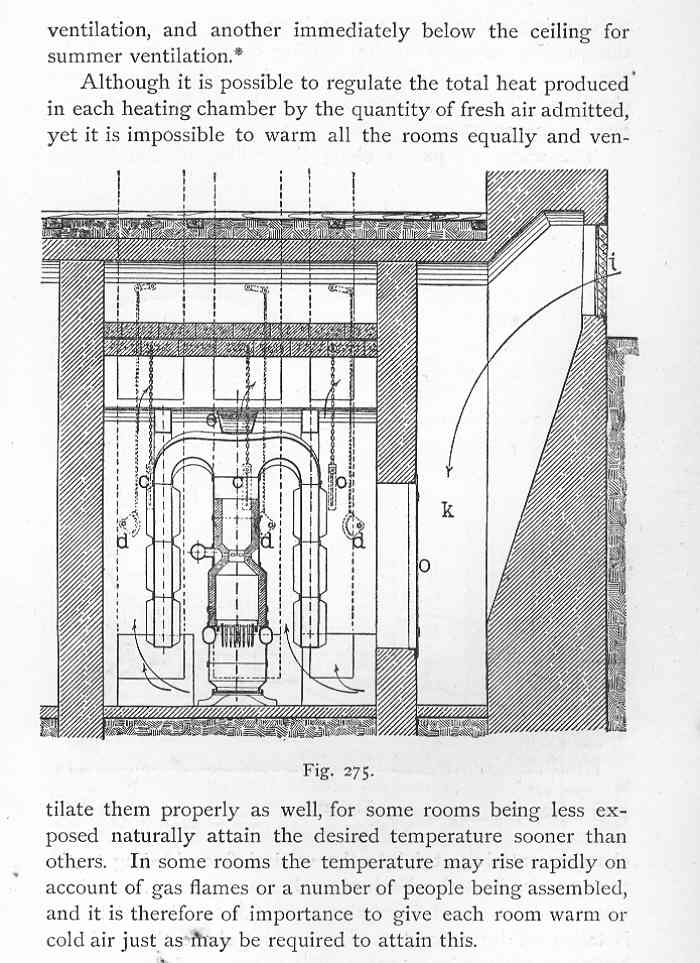
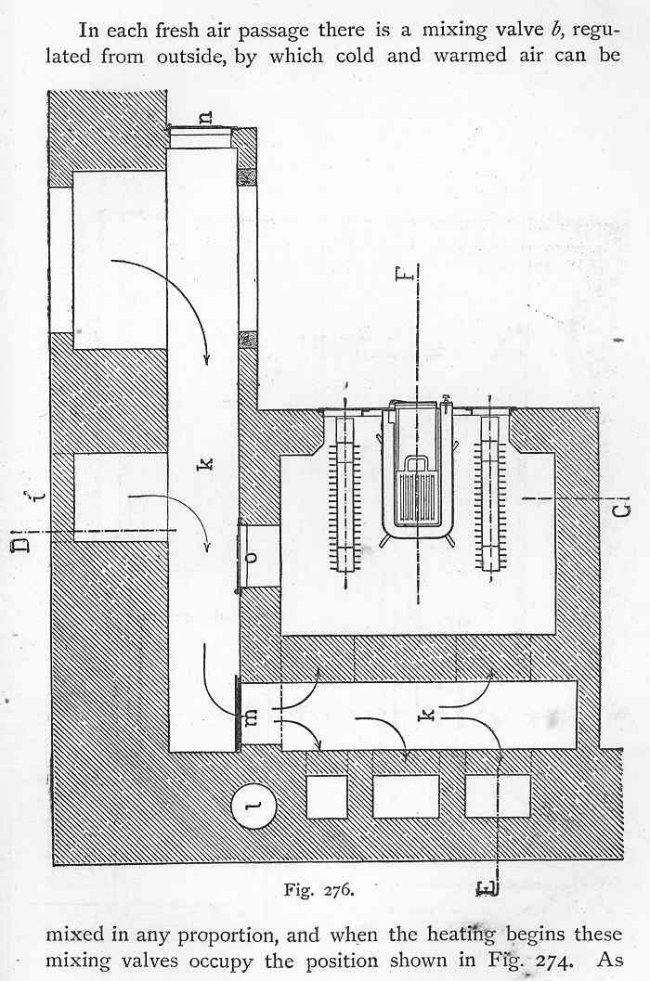
| An example of the plenum chamber arrangement for the installation of the warm air stove can be clearly seen in this Grundy drawing which dates from around 1890. |
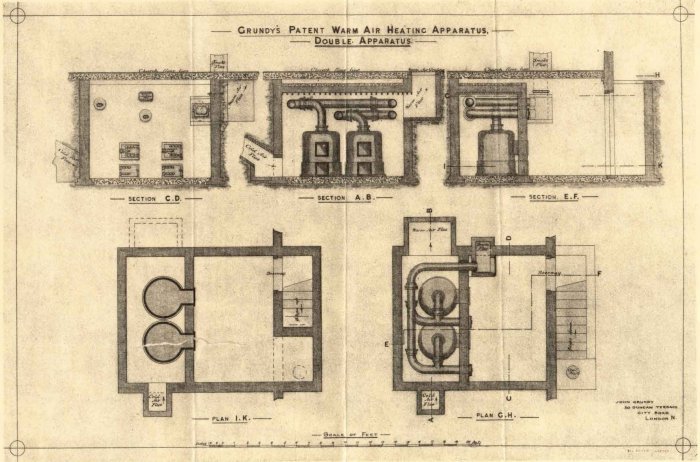
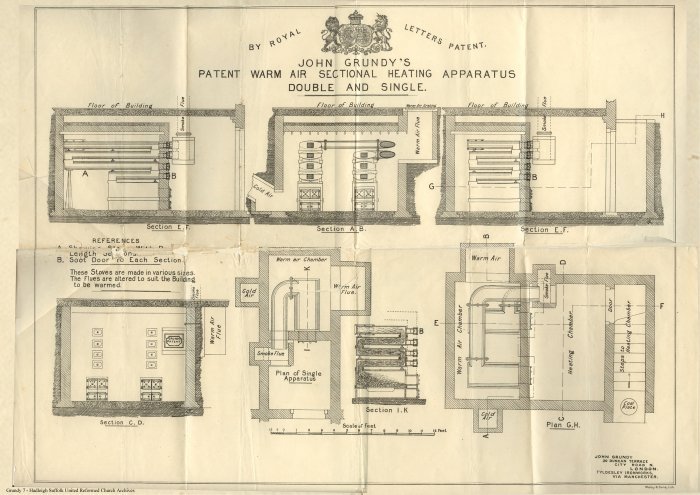
SIZE 10 "HESTIA" AIR HEATER
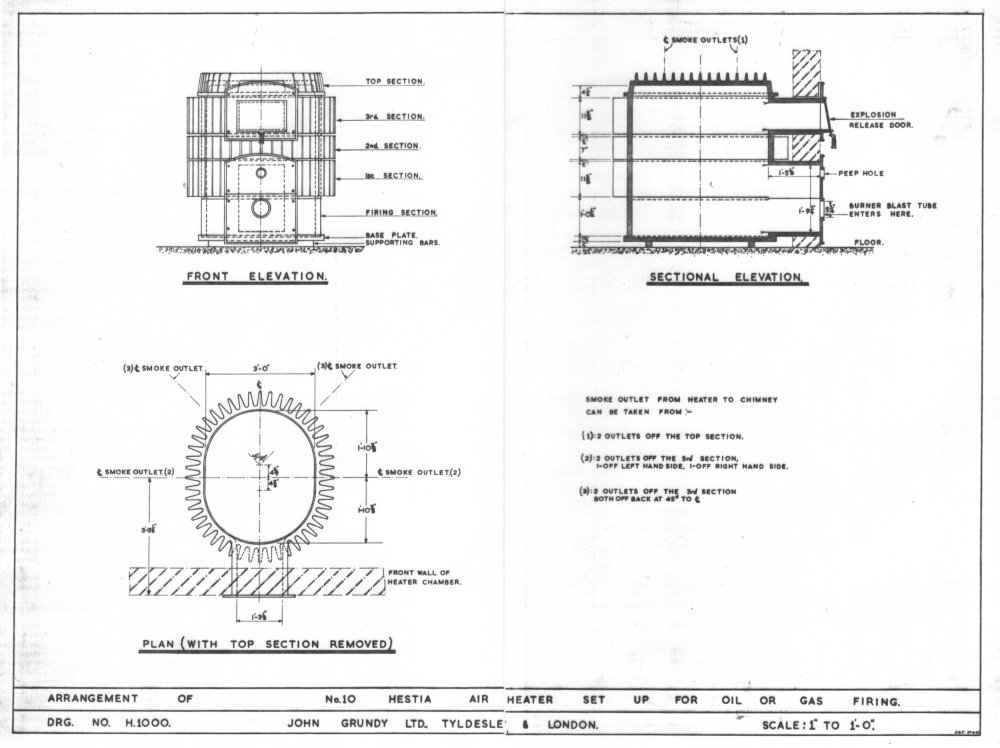
SMALL OVAL "Z" HESTIA AIR HEATER
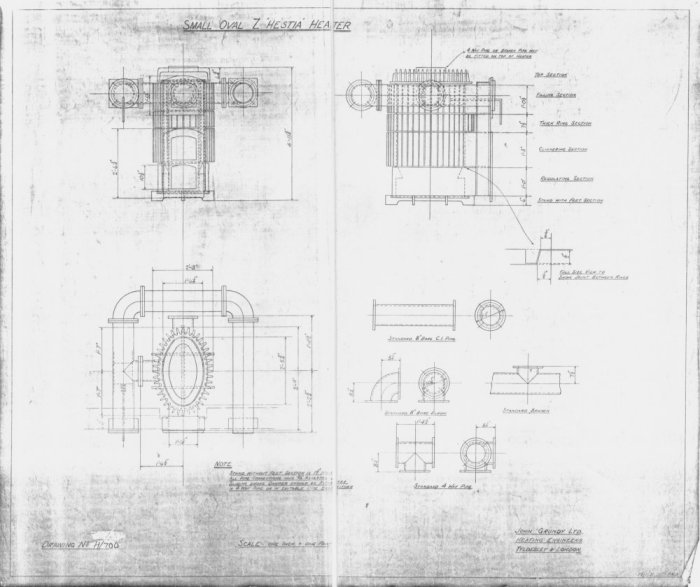
LARGEST SIZE OVAL "Z" HESTIA AIR HEATER
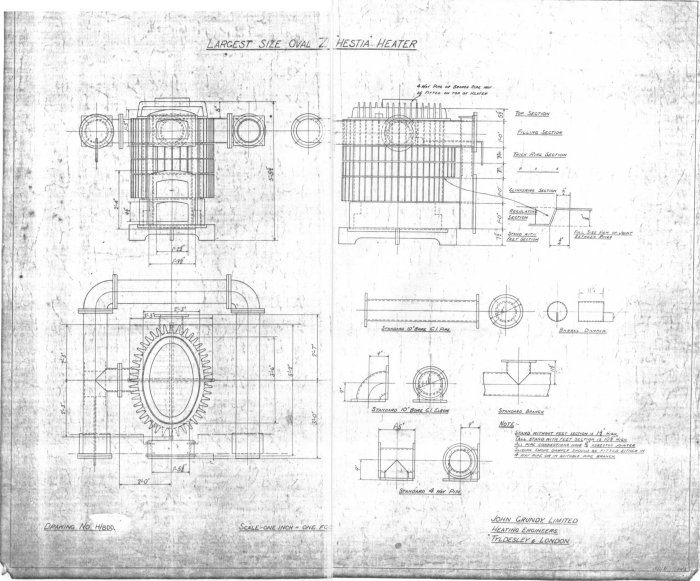
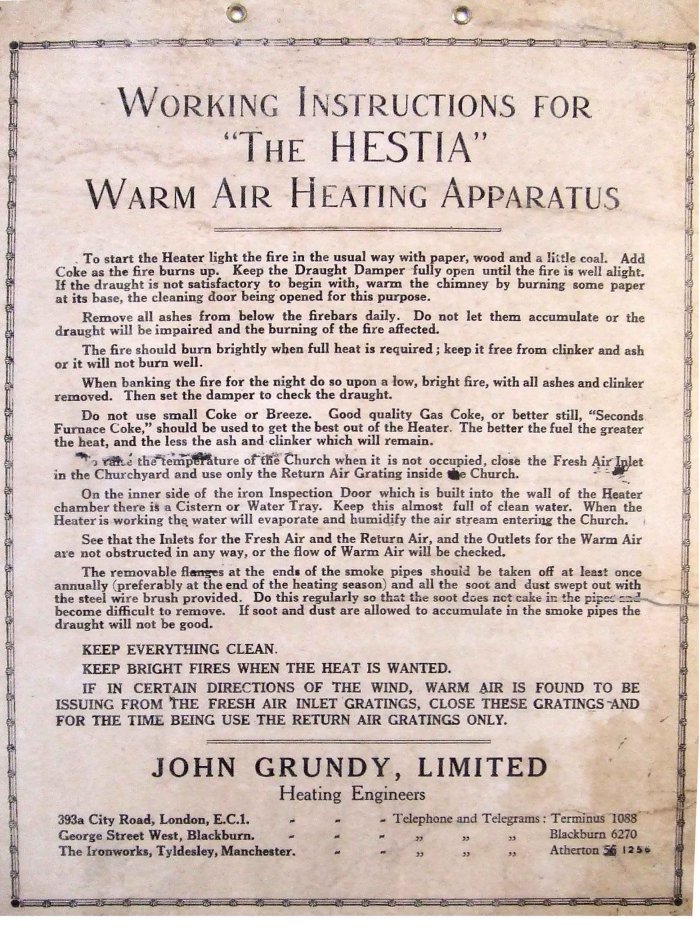
| St Michael
& All Angels Barnes London |
The church of St Michael & All Angels in Barnes
London was built in 1893 and it was during this time
that the Grundy heater and its associated warm air
ductwork system was installed.
This is the oldest known Grundy Warm air heater
installation discovered to date. The system comprises
two Small Oval Hestia "Z" heaters which supply warm
air to the church through 2 floor gratings. A floor
grating for the return air is also fitted. Fresh air is
supplied to the heating chamber through an
underground builders duct.
Layout of plant room before erection of the second gas burner.
Replacement access door fitted during the 1960's. |
Central access door to heating chamber |
Original Victorian style Grundy access door |
Views inside heating chamber showing external finning on
the outside of the cast iron Oval heaters. Note outlet heating
duct at high level on left hand picture.
View of combustion chamber inside the stove.
Note the top side outlet for exit of the flue gases.
Plant chamber with both gas burners now fitted
| United Reformed
Church Hadleigh Suffolk |
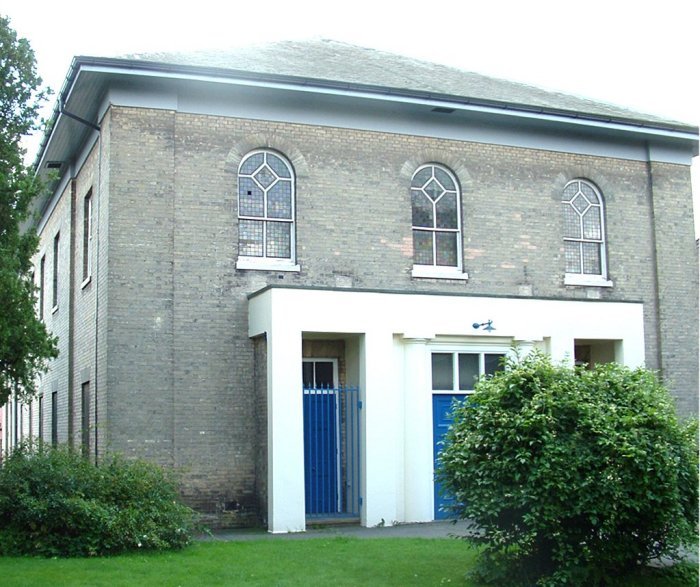
| One good example of a
Grundy warm air stove installation can be found in
the United Reformed Church at Hadleigh in Suffolk.
The building's first stove / heater was installed
in 1890 which was subsequently removed in
November 1952 and replaced with a size 1-Large Oval Z
type Hestia pattern. The stove was later converted
to gas firing in 1983. The stove's combustion chamber in 2005 was rejointed and relined with new refractory brickwork. The gas burner was refurbished. A selection of photos showing these works is show below. |
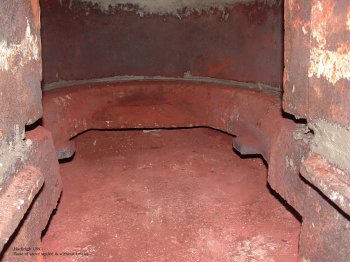 Internal base of
cleaned out stove
|
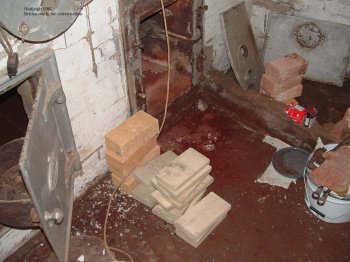 New refractory
bricks
|
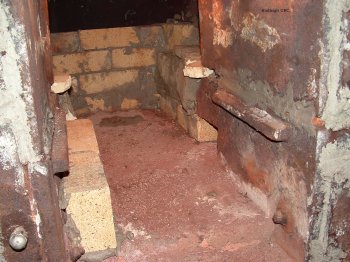 Refractory
brickwork during erection
|
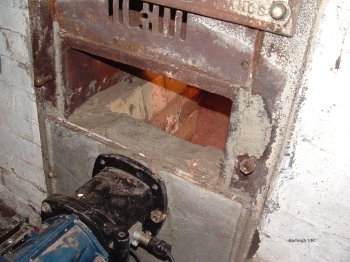 Gas burner
refitted
|
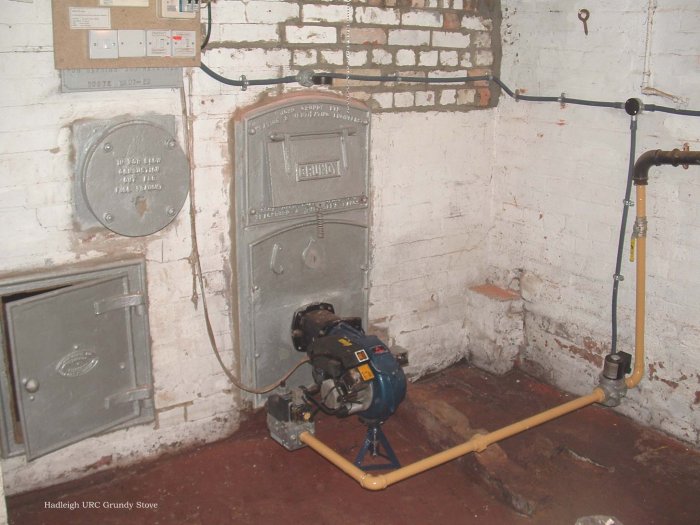
The completed installation
| Much of the original correspondence between the Church and John Grundy Ltd from 1889 still exists, which includes letters, receipts and drawings and is shown below in the following webpage. |
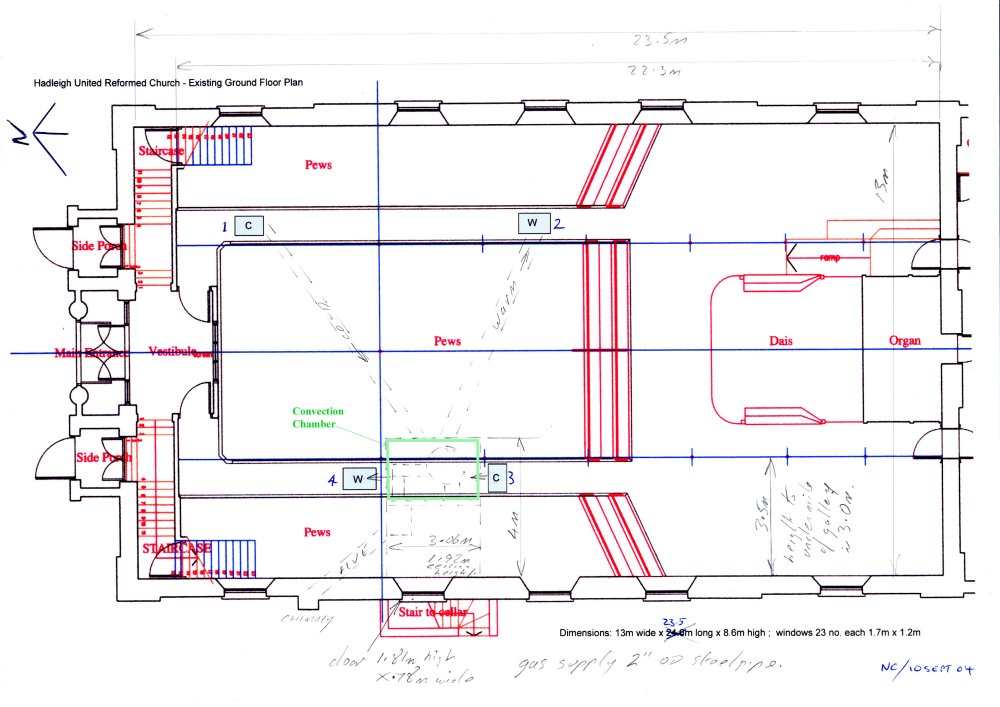
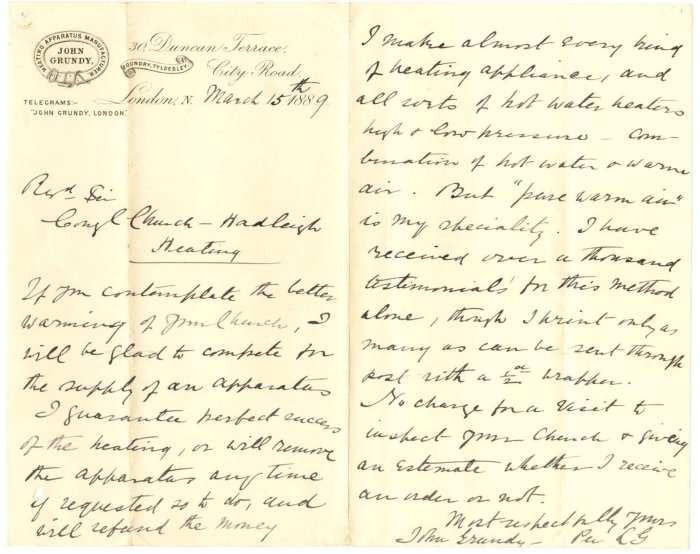
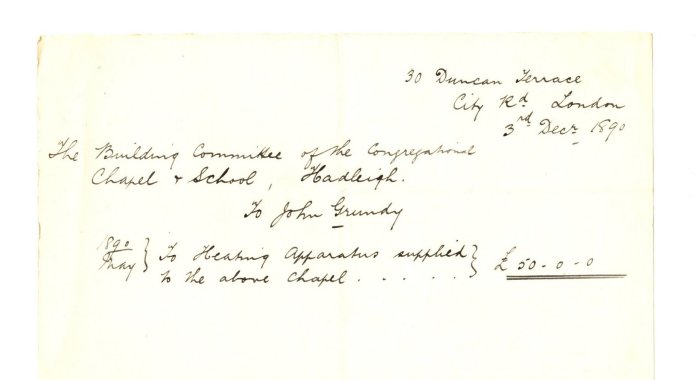
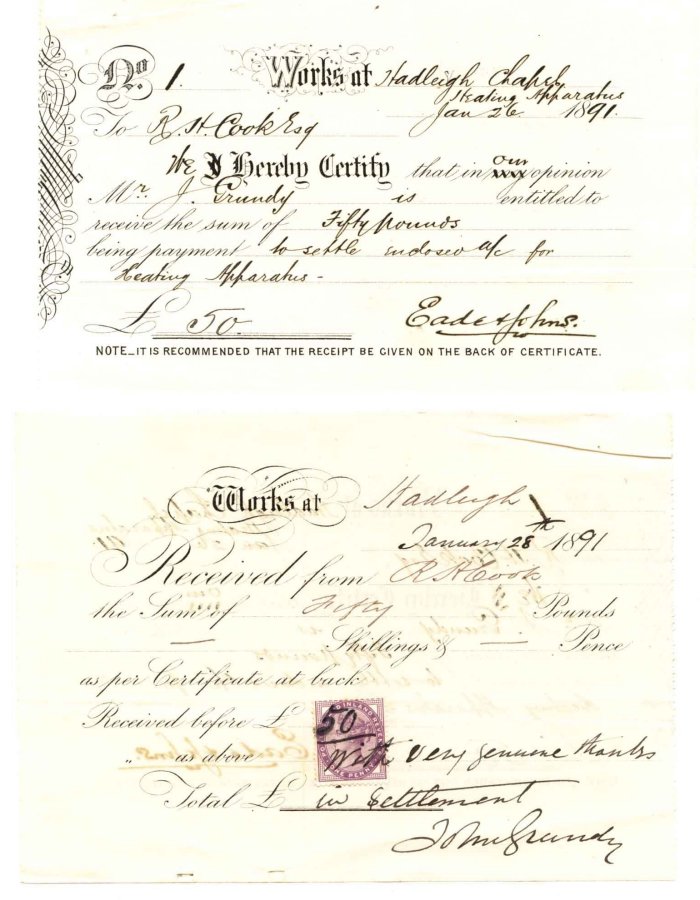
| St Peter's Church, Yaxley Peterborough, Cambridgeshire |
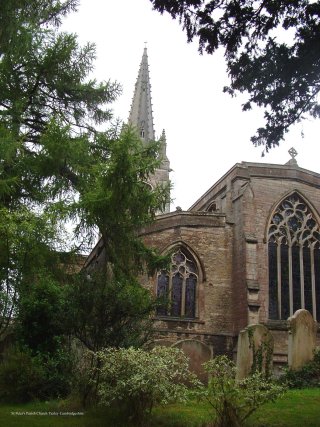 |
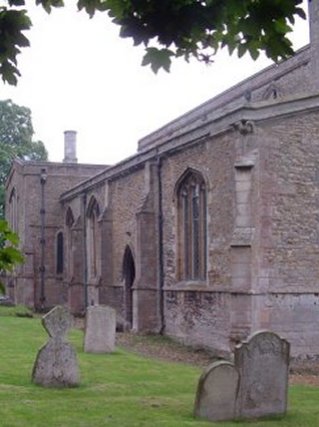 |
|
The church of St Peter at Yaxley, just east of the Great North Road near Peterborough, Cambridgeshire has been described as "a large and noble cruciform structure of rubble with stone dressings, and consists of chancel and nave, both with clerestory, aisles, transepts, south porch and an embattled western tower, with pinnacles and octagonal crocketed spire" (Kelly’s Directory 1903). This is a basic medieval church with the typical architectural layout of side aisles and chapels and built when thermal insulation and warmth in winter simply meant extra layers of clothing should be worn. |
|
Since 1966
the church has been heated by
warm air, provided by a John Grundy Igranic oil fired
cast iron
stove installed in a large floor
pit in the nave, central to the building as a
whole. It is likely that
this stove replaced an earlier one. The Igranic pattern
was the largest of the Grundy range of
cast iron sectional stoves, having three flue
outlets in its top section. At Yaxley
the outlets feed three finned economiser
pipes positioned horizontally and in parallel
under the nave floor which combine after about
3 metres to a single feed
connecting into the vertical flue and chimney
in the south transept wall. The chimney
can be seen in the exterior
photograph shown above.
|
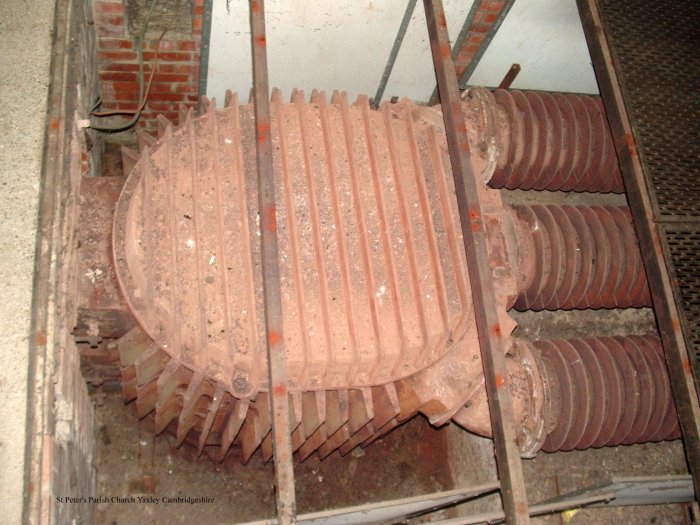
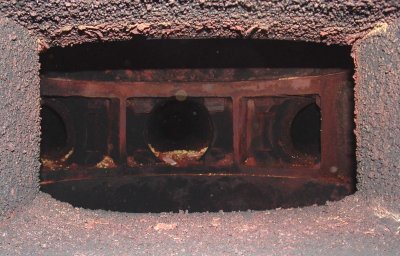
|
The stove and the economiser pipes
are covered in the aisle by cast iron floor
gratings, and the church is heated by the natural
circulation of warmed air up through these
gratings. Although
originally some cold fresh air from the outside
was fed in through pipes under the aisles, the
main air circulation is now achieved using fire
proof screens which stand beside the stove and
flue pipes, to draw down cool air at the sides of
the pit into the base of the stove.
With some of the floor gratings removed the
image shows the stove, economiser pipes and the
screens on both sides. The stove front and the oil burner are accessed via two cast iron trap doors in the nave floor as shown in the foreground of the photograph below. |
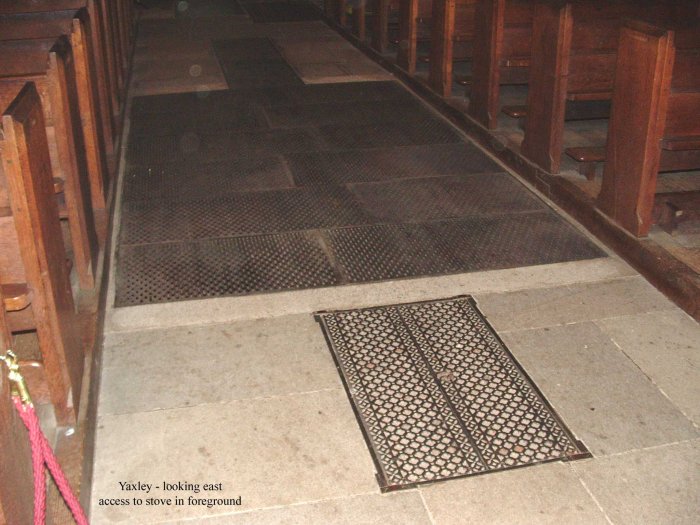
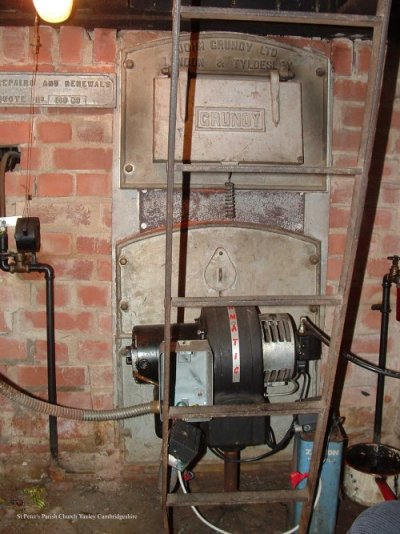 |
The
three section stove front is the typical layout
for Grundy oil or gas firing with the burner pipe
closest to the stove floor. Above it the peep hole
to monitor the flame and at the top the freely
hinged ‘explosion release door’.
In the top left of the photograph is the
cast iron plaque provided on most Grundy
installations which gives reference details for repairs and renewals; in the Yaxley
case showing the stove’s serial number of 159 and
the year of installation 1966.
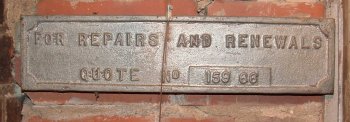 |
| A selection of John Grundy Ltd advertisements and other advertising leaflets. |
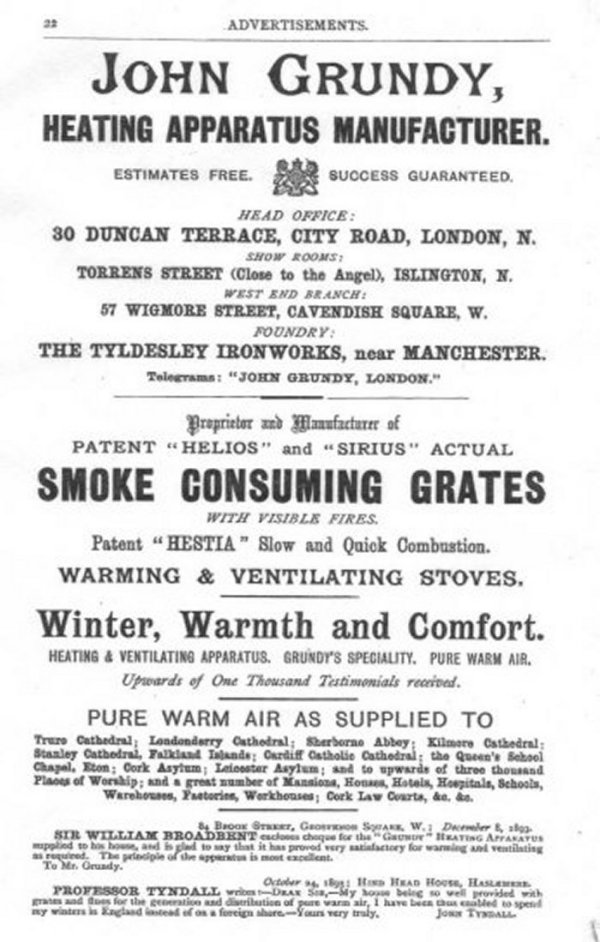
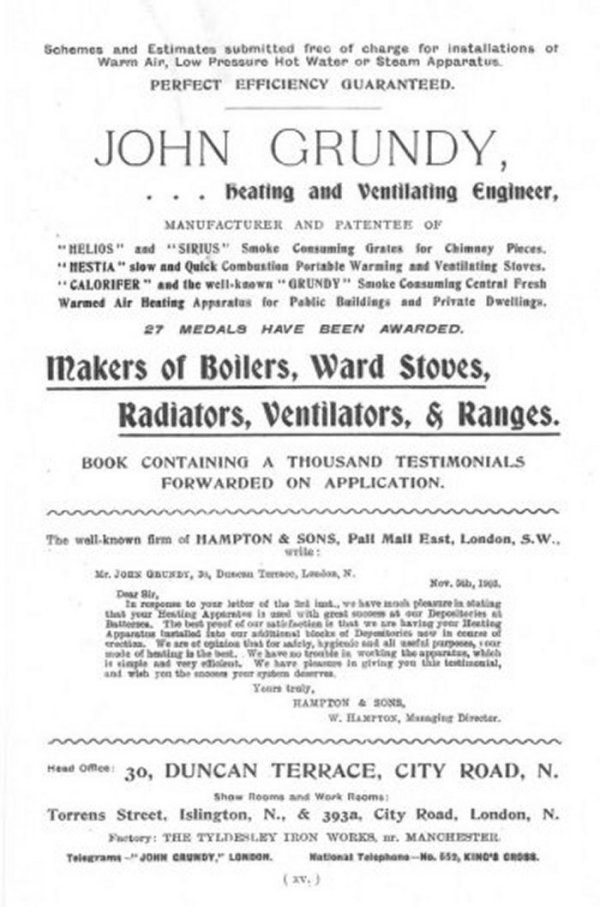
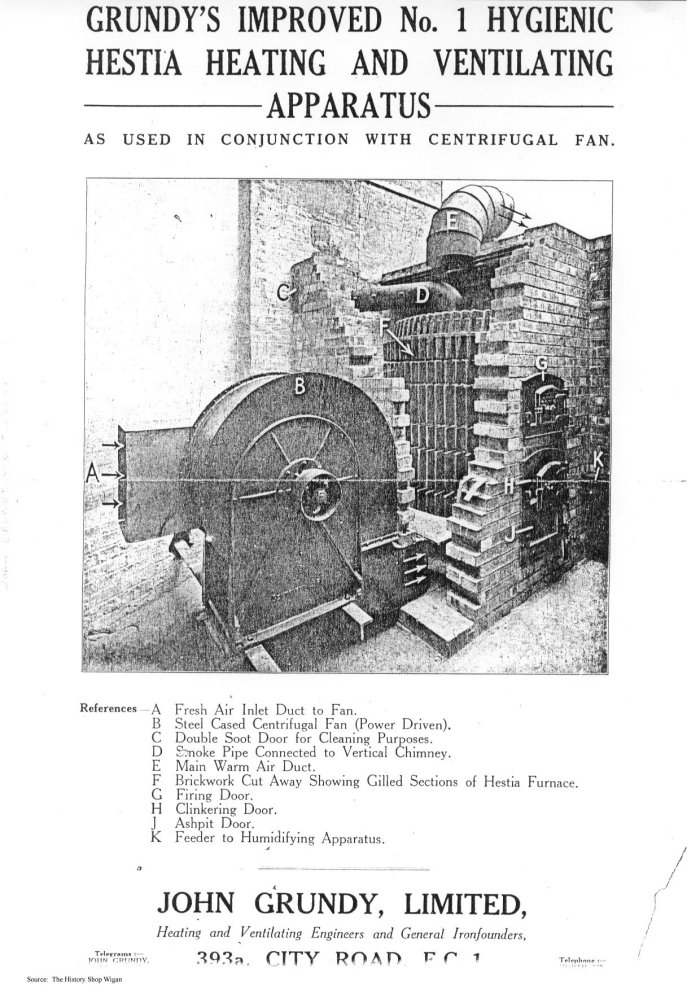
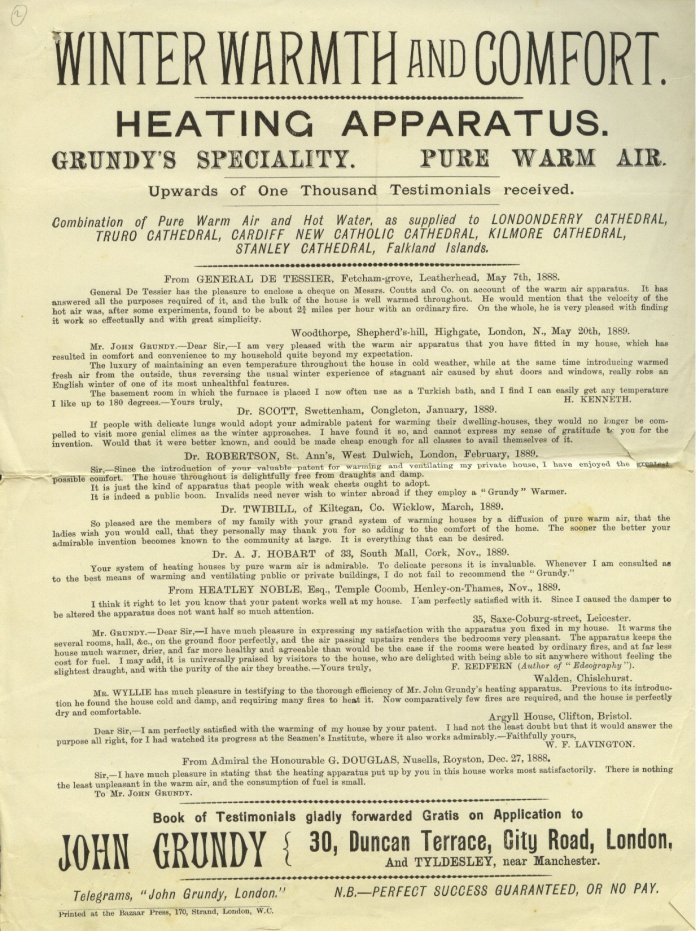
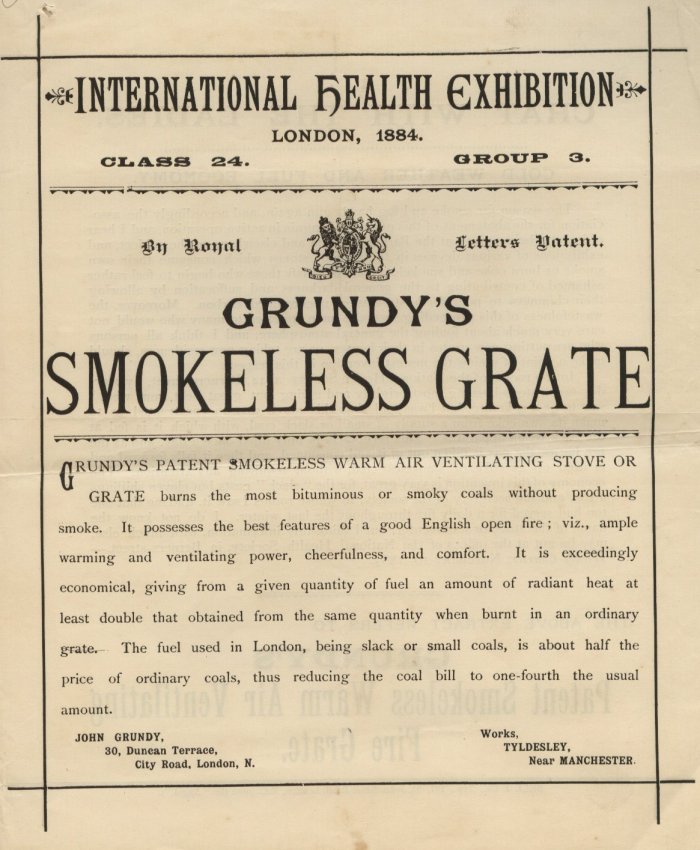
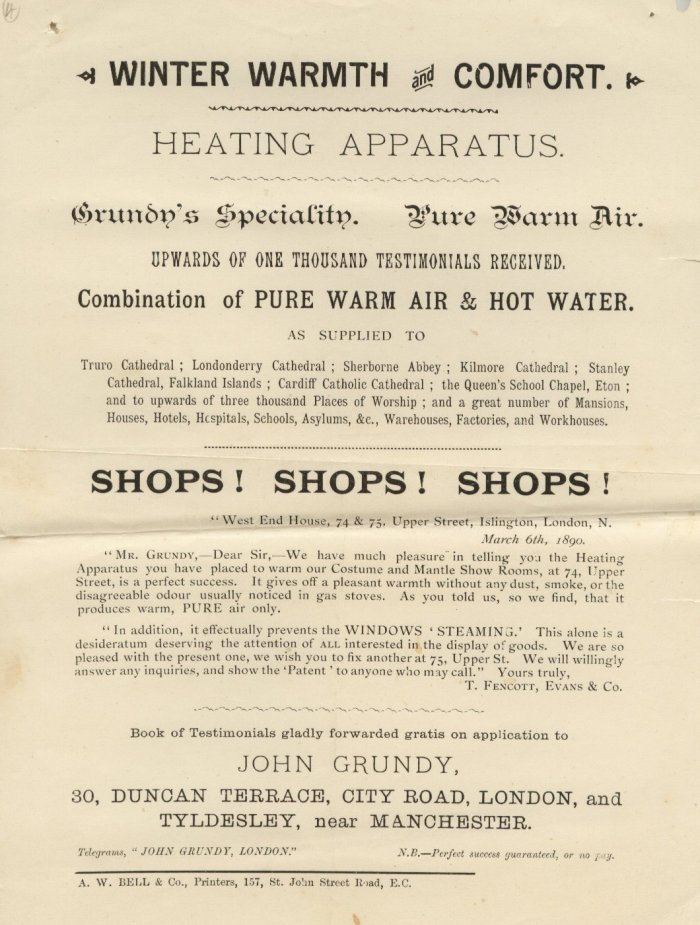
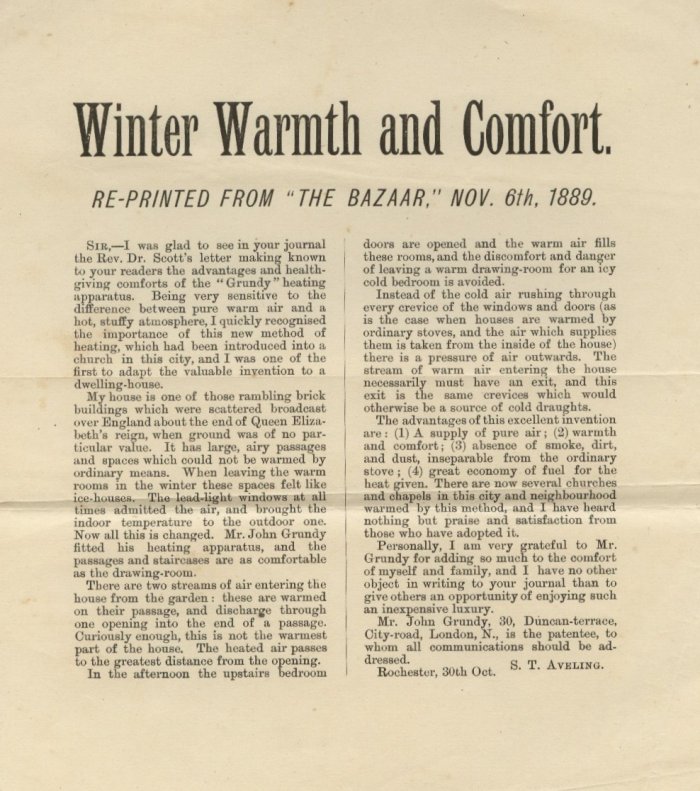
|
STOVE
INSTALLATION
DATE
1966
|
Rebricking and Rejointing
of the Combustion Chamber
|
After a number of years in operation for any warm air stove, it becomes necessary to carry out a complete renewal of the brickwork lining to the combustion chamber, due to the deterioration of the refractory brickwork inside the chamber. This is caused by the high temperatures and flame impingement. The high temperatures created within the combustion chamber will also cause the fire cement jointing between the horizontal cast iron sections to harden, eventually crack and become dislodged. These joints will all need to be resealed to prevent the products of combustion escaping from in between the sections out into the air ducts, which supply the warmed air that heats the building. The following series of pictures show the combustion chamber of a large size Grundy warm air stove being re-bricked and the joints between each of the sections resealed. |
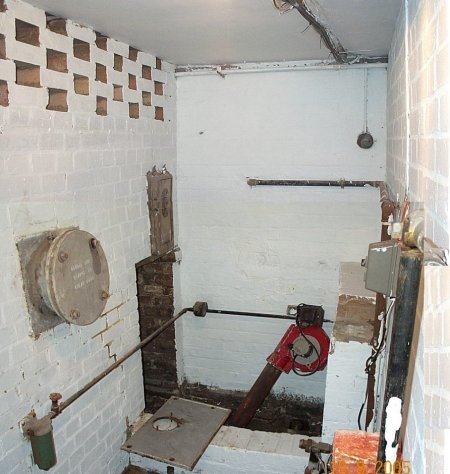 |
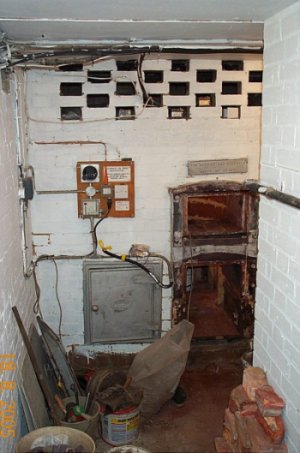 |
Old
firebricks have
been removed and the internal surfaces of the combustion chamber thoroughly cleaned |
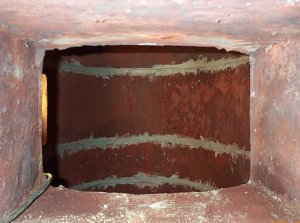 |
View through the opening for the top explosion relief door showing some of the internal joints between the sections that have been resealed using a suitable fire cement. |
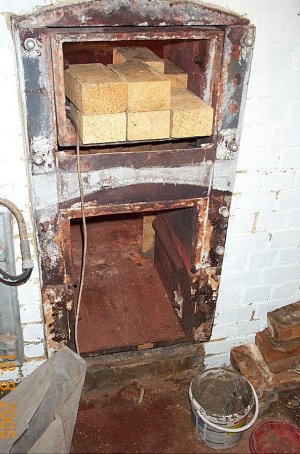 |
The
new refractory firebricks are placed in an
accessible position for the Service
Engineer working inside the
chamber to be able to use them for
building the firebrick wall.
|
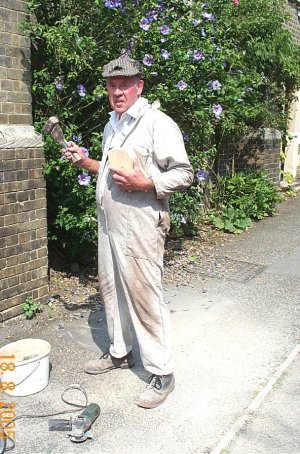 |
Service
engineer
Gordon Fishwick with the shaped firebricks
necessary to close the
gap
at the front of the chamber. |
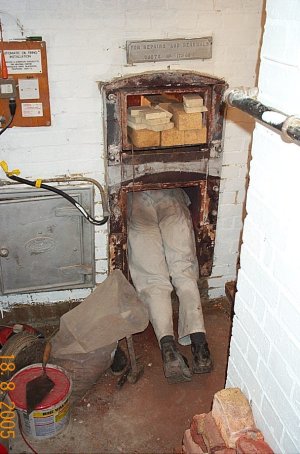 |
Disappearing
into
the
combustion chamber to complete the building of the firebrick wall. |
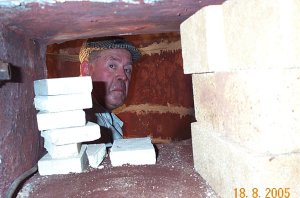 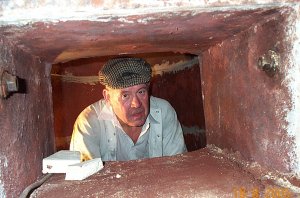 |
Working
inside the combustion chamber
(not really suitable for anyone suffering from claustrophobia). The cramped working space and conditions can clearly been seen. |
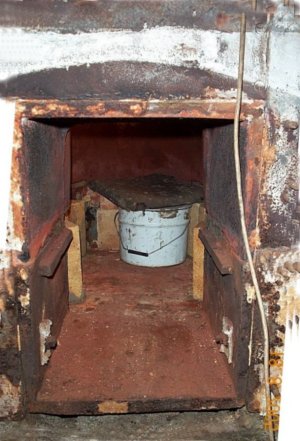 |
Another view
showing
the restricted and cramped working space inside the combustion chamber when cementing the firebricks into position. |
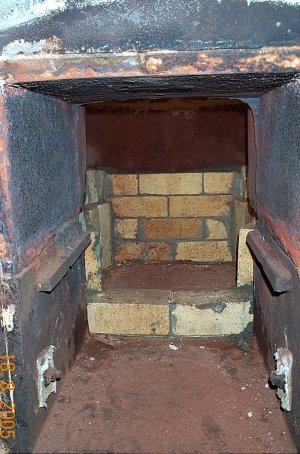 |
Internal view
of the completed firebrick lining. |
| John Grundy Ltd in the 1930's published
from their London Office a small promotional
booklet advertising "EIGHTY
YEARS of CHURCH HEATING" |
A copy of this booklet was kindly loaned to the
Heritage Group by Mr Edward L Jones of Tyldesley
who was employed by John Grundy Ltd for most of
his working life and was the foundry foreman at
the time when the firm closed in 1974
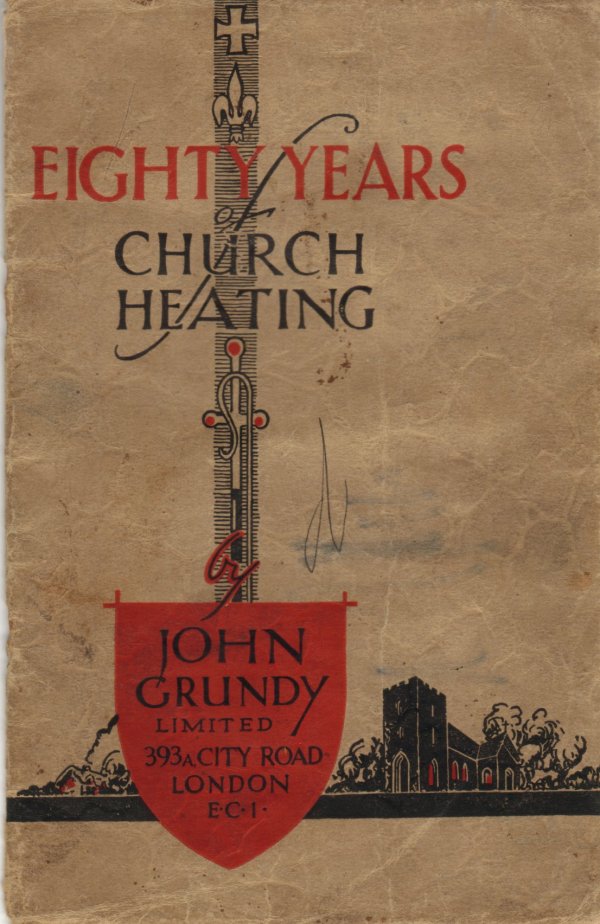
The following text is taken from the booklet.
|
Many
important inventions had their origin in small
beginnings, some the outcome of local discomfort
endured through the ages almost without question.
The
Grundy Warm Air system of Heating is a case in
point. Until the advent of Mr John Grundy, cold
feet were considered a natural accompaniment to
public worship, a discomfort almost inseparable
from Churchgoing in Winter. Indeed the radiant
heat of the congregation assisted by that of a
solitary stove was the only source of heat in most
buildings.
|
|
The
awakening took place when Mr John Grundy - a
warden of Tyldesley Chapel, near
Manchester- decided that something must be done
about it. He devised a scheme
of central heating for his Church, distributing
heat to all parts of the building. This novelty
so successful that it attracted the attention of
the Clergy of neigbouring parishes, eager
for like amenities.
So insistent
was the demand, that Mr Grundy, realising that
there was a great future for his discovery if he
cared to exploit it, at once accepted the
invitation from othe Churches and founded the firm
of JOHN GRUNDY LTD, soon to become a household
word in the heating world. Orders for the Grundy
warm air central heating system positively rained
in; applicants had to wait their turn, orders
being attended to in strict rotation. It seemed as
though the whole shivering world lay at Mr
Grundy's feet. Each installation became its own
advertisement. Churches and Church Halls
throughout Great Britain and Ireland clamoured for
the new heating system, and under the late Mr John
Grundy, son of the Founder , the business grew and
expanded in a very gratifying manner.
|
|
The private
houses of the aristocracy next received
attention, and warm air testimony came from the
nobility, great generals, and more important
still, great scientists. Professor
Tyndall declared that it was only the Grundy
System of Warm Air Heating that made
continued residence in this country possible
for him in the Winter.
Sir Henry Thompson, another great scientist, was so impressed with the Grundy Warm Air Installation supplied to him that he wrote a special account of it in his well-known book: "Diet in relation to age and activity." in which he pointed out that the Grundy System had the great advantge of circulating fresh warm air continuously, whereas hot-water pipes merely heated stale air. A very
important development in the Grundy business was
the launching of the Iron Foundry at Tyldesley.
Henceforth independant supplies and the highest
quality of material and workmanship were assured.
|
|
So
important had the name of Grundy become in the
heating world that when the Institution of
Heating and Ventilating Engineers was
inaugurated in 1898, it was considered essential
that Mr John Grundy should consent to become its
first president. The same office was filled in
1915 by the late Mr Herbert Grundy, the grandson
of the founder.
Since
the commencement of the business, thousands of
Churches and other buildings have been heated,
and the progress still continues. The principle
of the Grundy Warm Air System is the same now as
when the first Grundy's applied it so
successfully, but all that modern engineering
skill and science can do to increase its scope
and efficiency, has been incorporated.
As
with all valuable inventions success has led to
imitation. America has copied Grundy, so has the
Continent, but the British firm still holds
pride of place by reason of the wonderfully
effective design and durability of its products.
|
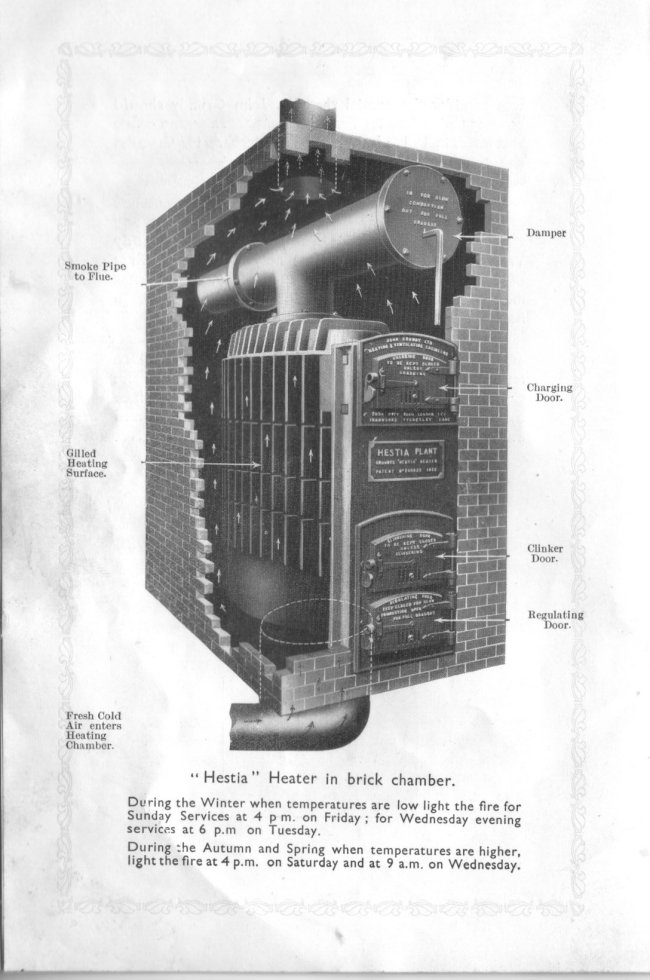
|
The
principle of heating by warm air is simplicity
itself, particularly in Churches and similar
buildings where it can be accomplished by
gravity only. In the small number of cases where
gravity cannot be relied upon, the introduction
of a fan is all that is necessary. Heating by
warm air is so simple that many people cannot
credit it and are apt to question uniform
distribution.
In
operation, air when heated becomes lighter than
the surrounding atmosphere. It immediately rises
at a high velocity in a perpendicular direction,
until it reaches the highest point in any
building. It then spreads in a horizontal
direction, and descends at a very low velocity.
|
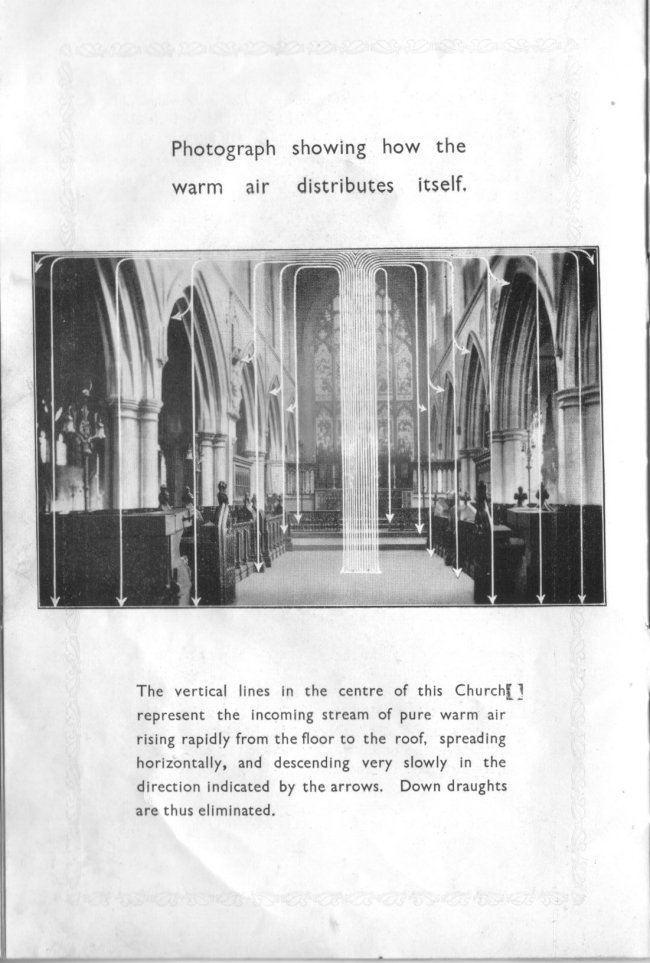
|
During
the process the leading stream of air gives up
some of its heat and becomes cooler and heavier.
The incoming stream of warm and light air, being
continuous, gradually displaces the cooler and
heavier air, causing it to descend at a very low
velocity, evenly throughout the building. Cold
down draughts are thereby eliminated. The air
descending at a very low velocity in addition to
giving an even temperature throughout, at equal
altitudes, ventilates the building - the slowly
moving air being essential for good ventilation.
It
is usual with the Grundy apparatus to arrange
the control so that the attendant is able to
circulate the air in the building by passing it
over the Heater, or he can pass over the Heater
new fresh air from the atmosphere only, thereby
getting perfect ventilation when the building is
in actual use.
When
it is found necessary to instal a fan, this is
only to ensure that a stream of warm air enters
each apartment in the building after which the
operation is exactly as described above.
|
